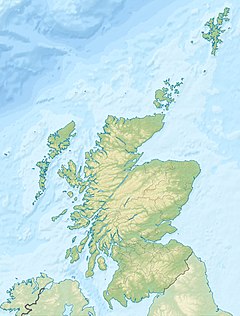Forth Road Bridge
| Forth Road Bridge | |
|---|---|

Forth Road Bridge, Edinburgh, Scotland
|
|
| Coordinates | 56°00′03″N 03°24′15″W / 56.00083°N 3.40417°WCoordinates: 56°00′03″N 03°24′15″W / 56.00083°N 3.40417°W |
| Carries |
|
| Crosses | Firth of Forth |
| Locale | Edinburgh and Fife, Scotland |
| Official name | Forth Road Bridge |
| Maintained by | Transport Scotland |
| Characteristics | |
| Design | Suspension bridge |
| Total length | 2,512 m (8,241 ft) |
| Width | 33 m (108 ft) dual two-lane carriageway, two cycle/footpaths |
| Height | 156 m (512 ft) |
| Longest span | 1,006 m (3,301 ft) |
| Clearance below | 44.3 m (145 ft) |
| History | |
| Constructed by | Sir William Arrol & Co., Cleveland Bridge & Engineering Company and Dorman Long |
| Opened | 4 September 1964 |
| Statistics | |
| Daily traffic | 65,000 vpd (2012 figures) |
| Toll | Free since 11 February 2008 |
The Forth Road Bridge is a suspension bridge in east central Scotland. The bridge, opened in 1964, spans the Firth of Forth, connecting Edinburgh, at Queensferry, to Fife, at North Queensferry. It replaced a centuries-old ferry service to carry vehicular traffic, cyclists and pedestrians across the Forth; railway crossings are made by the adjacent and historic Forth Bridge.
Issues regarding the continued tolling of the bridge, and those over its deteriorating condition and proposals to have it replaced or supplemented by an additional crossing, caused it to become something of a political football for the Scottish Parliament, which voted to scrap tolls on the bridge from 11 February 2008.
On 4 December 2015, the bridge was closed to all vehicular traffic, pedestrians and cyclists due to structural issues. The bridge reopened to all traffic except heavy goods vehicles (HGVs) on 23 December 2015, and it was reopened to HGVs on 20 February 2016.
The first crossing at what is now the site of the bridge was established in the 11th century by Margaret, queen consort of King Malcolm III, who founded a ferry service to transport religious pilgrims from Edinburgh to Dunfermline Abbey and St Andrews. Its creation gave rise to the port towns of Queensferry and North Queensferry, which remain to this day; and the service remained in uninterrupted use as a passenger ferry for over eight hundred years. As early as the 1740s there were proposals for a road crossing at the site, although their viability was only considered following the construction of the Forth Bridge in 1890.
The importance of the crossing to vehicular traffic was underpinned when the Great Britain road numbering scheme was drawn up in the 1920s. The planners wished the arterial A9 road to be routed across the Forth here, although the unwillingness to have a ferry crossing as part of this route led to the A90 number being assigned instead.
...
Wikipedia

